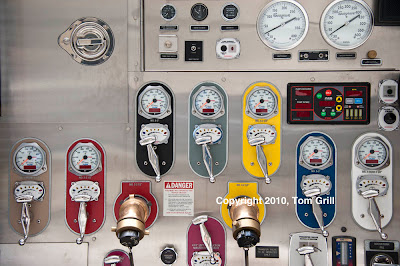Like many FX Nikon users, I eagerly awaited the arrival of the new AF-S Nikkor 28-300mm f/3.5-5.6G ED VR Zoom lens. What was there not to like? The specs were great -- a full range zoom, moderately fast lens opening, small size (only 4.5" long and 28.2oz), an ability to focus as close as 18" over the entire zoom range, VRII motion control, and some ED and aspherical lens elements. At $1050 this looked to be an ideal lens for those times when you wanted to lighten your load and carry only one body, like maybe the D700, and one lens. The higher price even encouraged me in my thinking. I figured that Nikon would only put out a high quality lens in the over $1k price range. When I unpacked the lens, its heft and feel reenforced my positive anticipation. So I mounted it on a D700 and went about my standard tests for lens quality -- and that is when my bubble burst.
Note how the bricks bow outward at the center of the edges but
then come back in and out again towards the corners.
This type of distortion is very difficult to correct.
then come back in and out again towards the corners.
This type of distortion is very difficult to correct.
First thing I did was run the lens through my standard brick wall test. You can see some of the results in the images above. Rectilinear distortion is very apparent at the extreme focal lengths. If it were only pincushion and barrel distortion it would not be so bad, as both are easily corrected in post-processing, but at 28mm the images showed high pincushion distortion in the middle of the frame edges plus barrel distortion as the lines approached the corners. This type of distortion is almost impossible to correct fully. Vignetting was significant at the shorter focal lengths, but this is easily fixed in post-processing. Substantial chromatic distortion came into play at all focal lengths. The corners are noticeably soft at all focal lengths. To top it off, the images had an overall soft quality, and never even approached the crisp sharpness of the professional Nikkor zooms like the 24-70mm, and 70-200mm.
34mm length at f/8 1/1000 sec, ISO 400 Click here to see full res image
150mm f/11 1/400 sec, ISO 400 Click here to see full res image
An advantage to this focal length zoom is that you can quickly
switch from close to distant views of the same subject.
An advantage to this focal length zoom is that you can quickly
switch from close to distant views of the same subject.
The good news is that some of the distortion can be corrected in post-processing. Photoshop does not yet have a plug-in for this lens, but I was able to cancel the chromatic distortion, eliminate the vignetting, and correct the rectilinear distortion in all except the most extreme wide angle focal lengths. Unfortunately, softness is not something that is correctable so the images maintained their overall mushy quality. Even stopping down to f/8 didn't significantly improve the softness. If you limit the lens to a zoom range of 35-200mm the results are better.
82mm f/5.6 1/160 sec, ISO 800 Click here to see high res image
I debated whether I would keep this lens despite its aberrations -- limiting my use to those circumstances where I would really only carry a camera if it were this small. I figured that having even a mediocre system was better than having no system with me. Ultimately, I realized I would not opt for this choice if there was even a slight chance of obtaining a usable professional image by carrying the camera around. So that limited my use of this lens to personal shooting of the "home snapshot" variety. As a result of my tests, I would not use this lens for serious stock photography, where images need to be 50mb in size and distortion-free.
250mm f/8 1/1250 sec, ISO 400 Click here to see high res image
Note how the building is not sharp and softness increases towards the frame edge.
Note how the building is not sharp and softness increases towards the frame edge.
Bokeh was not very pleasant, but I won't hold that against a lens with a maximum opening of f/3.5-5.6. If you plan on using this lens with a pop-up flash, remove the lens hood as it will cast a shadow at even the shortest focal length.
116mm f/8 1/800sec, ISO 400 The lens will focus down to 18" at all focal lengths.
The holy grail of zoom lenses has always been one that could be hand-held, with a focal length range from very wide to extra long telephoto, and close-focus ability. The specs of this lens fill that bill but not without substantial compromise in image quality. The quest for the holy grail will have to continue as an unattained dream.











